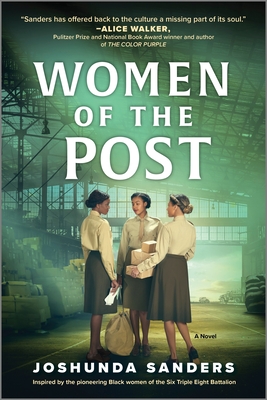 Women of the Post by Joshunda Sanders
Women of the Post by Joshunda Sanders Format: eARC
Source: supplied by publisher via Edelweiss
Formats available: hardcover, large print, paperback, ebook, audiobook
Genres: historical fiction, World War II
Pages: 368
Published by Park Row Books on July 18, 2023
Purchasing Info: Author's Website, Publisher's Website, Amazon, Barnes & Noble, Kobo, Bookshop.org, Better World Books
Goodreads
An emotional story, based on true events, about the all-Black battalion of the Women's Army Corps who found purpose, solidarity and lifelong friendship in their mission of sorting over one million pieces of mail for the US Army.
1944, New York City. Judy Washington is tired of working from dawn til dusk in the Bronx Slave Market, cleaning white women’s houses and barely making a dime. Her husband is fighting overseas, so it's up to Judy and her mother to make enough money for rent and food. When the chance arises for Judy to join the Women’s Army Corps (WAC) and the ability to bring home a steady paycheck, she jumps at the opportunity.
Immediately upon arrival, Judy undergoes grueling military drills and inspections led by Second Officer Charity Adams, one of the only Black officers in the WAC. Judy becomes fast friends with the other women in her unit—Stacy, Bernadette and Mary Alyce—who only discovered she was Black after joining the army. Under Charity Adams’s direction, they are transferred to Birmingham, England, as part of the 6888th Central Postal Battalion—the only unit of Black women to serve overseas in WWII. Here, they must sort a backlog of over one million pieces of mail.
The women work tirelessly, knowing that they're reuniting soldiers to their loved ones through the letters they write. However, their work becomes personal when Mary Alyce discovers a backlogged letter addressed to Judy that will upend her personal life. Told through the alternating perspectives of Judy, Charity and Mary Alyce, Women of the Post is an unforgettable story of perseverance, female friendship, romance and self-discovery.
My Review:
American women had many and various reasons for signing up for the Women’s Army Corps in World War II, from the Corps’ beginning as the Women’s Army Auxiliary Corps in 1942 through its transition to the WAC in 1943 – and all the way through its eventual disbanding in 1978.
For the three African-American women portrayed in Women of the Post, the reasons were every bit as varied, but underlying those reasons was that their options for highly paid civilian war work were practically non-existent because of the color of their skin. They all wanted to make a difference – not just for themselves but in how women of color were treated both during and after the war.
And it was the best job they thought they were ever likely to have.
The story of the 6888th Central Postal Directory Battalion is told through the experience of three characters, one based directly on a real historical figure, and two who are composites of the real women who served in the 6888th.
Through Major Charity Adams’ eyes we see the perspective of the first African-American female officer in the WACs. She knows that the future rides on the shoulders of her unit, and that they will all have to be three times as good with less than half the training and equipment in order to stay the course they’ve set for themselves. A course that few in the Army or outside it believe that women like them are capable of.
From the point of view of Judy Washington we experience the way that the world looks and especially works from someone who is closed out of every opportunity except for poorly paid domestic work conducted under the thumbs of privileged white women who can steal the meager coins from their purses and pay it back to them as ‘wages’. That the work is solicited through an institution named the Bronx Slave Market is bitter icing on a terrible cake. (But another facet of U.S. history that needs more exposure)
But Judy wants more from her life and her world. She wants a decent wage for a day’s work. She wants to see a broader horizon than her mother does or expects her to settle for. And she wants to see if she can catch word of her husband, himself in uniform, who she hasn’t heard from in months.
Mary Alyce Dixon is the character who gives readers the clearest picture of what life is like for an African-American woman in the WAC’s, because it’s not the life she ever expected to have. Her long-deceased father was ‘colored’, but her mother never told her. When the Army receives her birth certificate, her world shifts under her feet. She doesn’t know how to be the person she has just learned that she is, and her education in living on the other side of the color line is sometimes harsh but always an eye-opener for readers who have not lived her experience.
That this unit comprised entirely of women of color, from its officers on down, forms into a band of sisters is not a surprise, but is a delight. That they exceed every goal set for them in clearing the seemingly years’ worth of backlogged mail to and from U.S. troops stationed in Europe is a boost to morale on both the front lines AND the homefront.
And the story of these unsung heroines is one that absolutely cried out to be told.
Escape Rating B+: I ended up with some mixed feelings about this story, a bit of a conflict between what I thought of the true history that inspired it vs. what I felt about the fictionalized version presented between these pages.
Women of the Post is a story of ‘hidden figures’, very much like the book of that title. It’s one of those stories that isn’t widely known, but truly should be. However, that the story is not as well-known as it should be allows this fictionalization of it to rise above the overcrowded field of World War II fiction.
I loved seeing this important and inspiring story brought to such vivid life.
The Six-Triple-Eight really existed, and they performed the work outlined in the book. They were the only unit of African-American women to serve overseas during the war. The ONLY unit. Think about what that says about racism and bigotry in the U.S. during the war.
The story also feels true to life in its depiction of the pervasive racism, sexism and all the other heinous bigotries that these women, and in fact ALL women of color, faced not just during their military service, but also before and after it.
Those prejudices provide a harsh, driving drumbeat that persists throughout the narrative. As it did in real life. It can make for a hard read but a necessary one. It has to have been, and still be in too many ways, even more difficult to live.
But that drumbeat does have an effect on the story as it’s told, because it’s always there and confronts the characters around pretty much every corner.
The story being told, however, creates its dramatic tension out of the interactions of the characters, and from the war that is being waged all around their postings. From a certain perspective, not a lot happens – although plenty is happening all around them. For a story that takes place in the midst of war, the pace can seem a bit leisurely even as it pulls the reader along. It’s more of a slice of life in wartime story than a big drama.
What makes it work are the three characters we follow, Major (later Lieutenant Colonel) Charity Adams, Judy Washington, and Mary Alyce Dixon. While Major Adams is the real-life heroine of this story, it’s through Mary Alyce’s learning curve that the reader gets the sharpest picture of what life is really like for the Women of the Post, before, during and after their wartime service.


 The Wayward Prince (The Daughter of Sherlock Holmes Mysteries, #7) by
The Wayward Prince (The Daughter of Sherlock Holmes Mysteries, #7) by  Escape Rating A-:
Escape Rating A-: 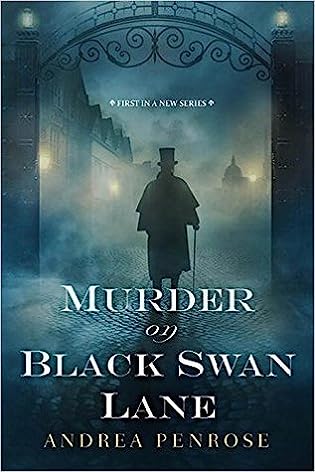 Murder on Black Swan Lane (Wrexford & Sloane, #1) by
Murder on Black Swan Lane (Wrexford & Sloane, #1) by 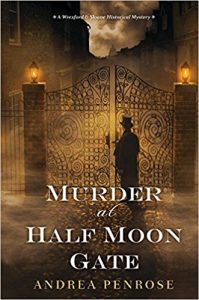 The Sherlockian overtones of Wrexford’s unemotional demeanor contrasted with Sloane’s carefully banked emotions as well as their opposition in gender and station gives this case much of its dramatic tension as well as providing plenty of opportunity for the characters to spark off each other so hard they very nearly set the scene afire. Not that there aren’t plenty of fires and even explosions of a slightly more mundane origin to deal with! They are clearly people who can’t be neutral about each other, even when they are on the same side. Where those sparks will lead them will undoubtedly be explored in the books to come, along with whatever else Sloane is hiding from both Wrexford and from herself.
The Sherlockian overtones of Wrexford’s unemotional demeanor contrasted with Sloane’s carefully banked emotions as well as their opposition in gender and station gives this case much of its dramatic tension as well as providing plenty of opportunity for the characters to spark off each other so hard they very nearly set the scene afire. Not that there aren’t plenty of fires and even explosions of a slightly more mundane origin to deal with! They are clearly people who can’t be neutral about each other, even when they are on the same side. Where those sparks will lead them will undoubtedly be explored in the books to come, along with whatever else Sloane is hiding from both Wrexford and from herself. A Disappearance in Fiji by
A Disappearance in Fiji by 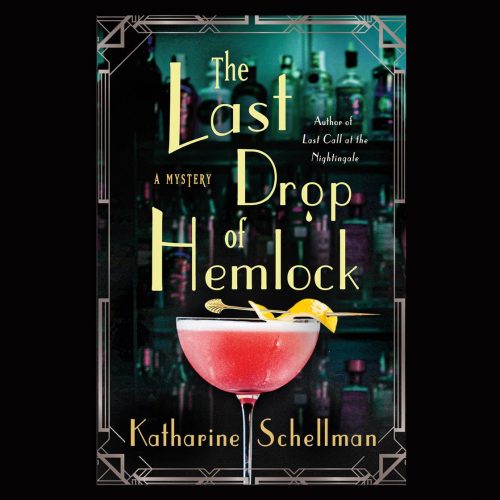 The Last Drop of Hemlock (Nightingale Mysteries, #2) by
The Last Drop of Hemlock (Nightingale Mysteries, #2) by  Escape Rating B: As I was listening to The Last Drop of Hemlock, I remembered what I wrote about the first book in this series,
Escape Rating B: As I was listening to The Last Drop of Hemlock, I remembered what I wrote about the first book in this series, 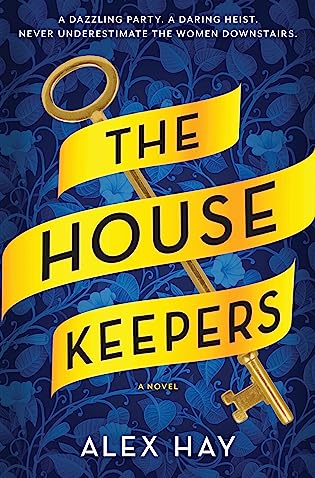 The Housekeepers by
The Housekeepers by  Escape Rating B: The Housekeepers is all about the heist. Which means that the characters take a back seat to the caper on this thrill ride, and the story is more about putting the operation together and taking the target apart than it is about the gang who are pulling it off.
Escape Rating B: The Housekeepers is all about the heist. Which means that the characters take a back seat to the caper on this thrill ride, and the story is more about putting the operation together and taking the target apart than it is about the gang who are pulling it off.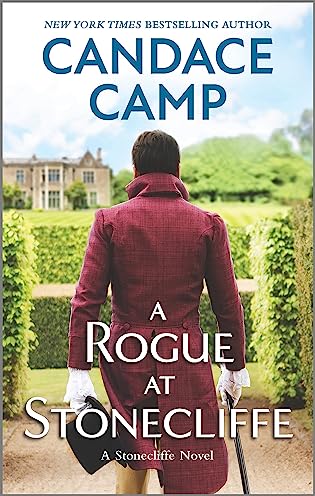 A Rogue at Stonecliffe (Stonecliffe, #2) by
A Rogue at Stonecliffe (Stonecliffe, #2) by  Fictionally speaking, the Napoleonic Wars are a gift that just keeps on giving. And taking, as happens in this second book in the
Fictionally speaking, the Napoleonic Wars are a gift that just keeps on giving. And taking, as happens in this second book in the 
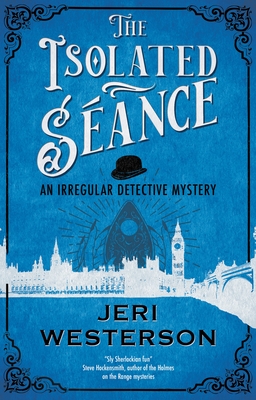 The Isolated Séance (An Irregular Detective Mystery #1) by
The Isolated Séance (An Irregular Detective Mystery #1) by 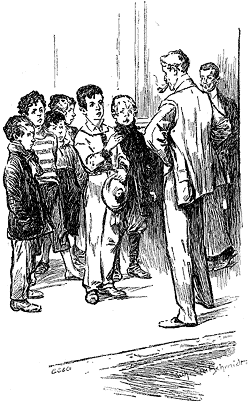
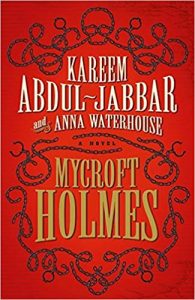 (Although both men are very young, Watson’s circumstances as a black man in a city that is prejudiced against him at every turn gives him a bit of caution and maturity that Badger sadly lacks. Watson’s perspective as someone who will always be considered an outsider even before he opens his mouth reminds this reader of the relationship between a young Mycroft Holmes and the more mature Cyrus Douglas in Kareem Abdul Jabbar’s
(Although both men are very young, Watson’s circumstances as a black man in a city that is prejudiced against him at every turn gives him a bit of caution and maturity that Badger sadly lacks. Watson’s perspective as someone who will always be considered an outsider even before he opens his mouth reminds this reader of the relationship between a young Mycroft Holmes and the more mature Cyrus Douglas in Kareem Abdul Jabbar’s 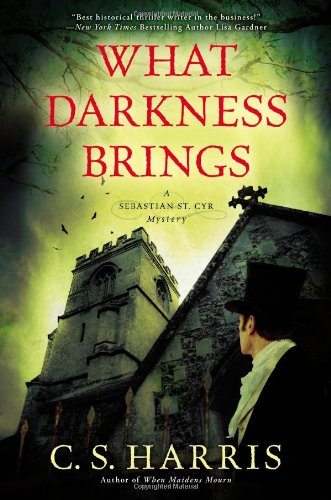 What Darkness Brings (Sebastian St. Cyr, #8) by
What Darkness Brings (Sebastian St. Cyr, #8) by 
 Escape Rating A: It’s not much of a surprise that after
Escape Rating A: It’s not much of a surprise that after 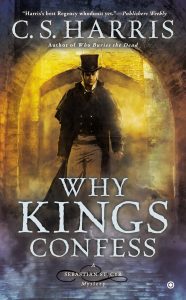 The way the murder, the theft plot and the real history branched and intertwined made this entry in the series one hell of a wild ride, while still tying up loose ends from previous entries and opening up entirely new fields of questions for future books in the series – some of which have admittedly been answered by the point where the series as a whole rests – hopefully temporarily – after
The way the murder, the theft plot and the real history branched and intertwined made this entry in the series one hell of a wild ride, while still tying up loose ends from previous entries and opening up entirely new fields of questions for future books in the series – some of which have admittedly been answered by the point where the series as a whole rests – hopefully temporarily – after 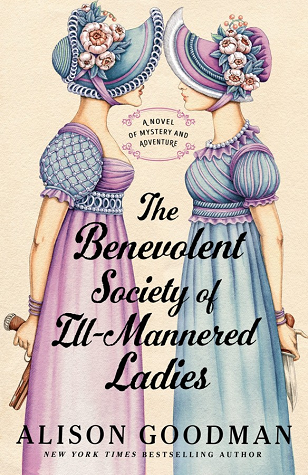 The Benevolent Society of Ill-Mannered Ladies (The Ill-Mannered Ladies, #1) by
The Benevolent Society of Ill-Mannered Ladies (The Ill-Mannered Ladies, #1) by 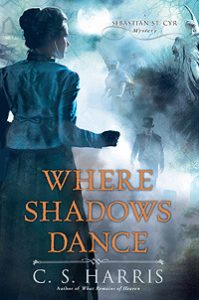 Both the Colebrook sisters and St. Cyr are conducting their investigations during the Regency period, in this book specifically 1812 – which is also the year in which books 4 through 8 of the St. Cyr series (
Both the Colebrook sisters and St. Cyr are conducting their investigations during the Regency period, in this book specifically 1812 – which is also the year in which books 4 through 8 of the St. Cyr series (